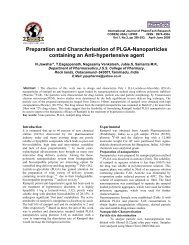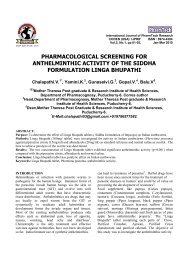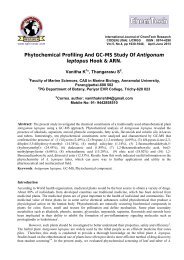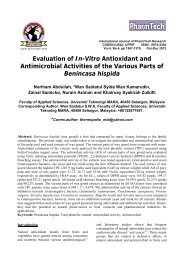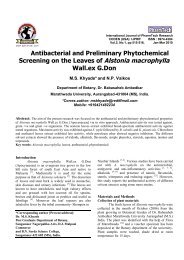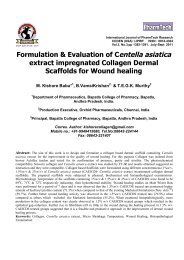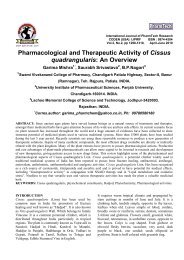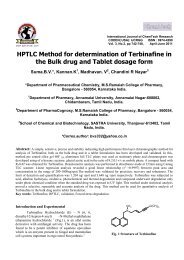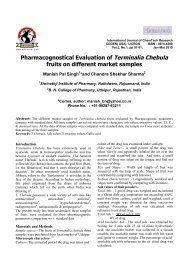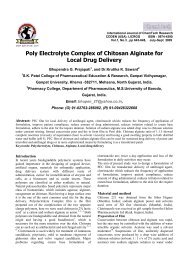Influence of ethanolic extract of Borassus flabellifer L. male flowers ...
Influence of ethanolic extract of Borassus flabellifer L. male flowers ...
Influence of ethanolic extract of Borassus flabellifer L. male flowers ...
You also want an ePaper? Increase the reach of your titles
YUMPU automatically turns print PDFs into web optimized ePapers that Google loves.
Mahesh S Paschapur et al /Int.J. PharmTech Res.2009,1(3) 552<br />
their mode <strong>of</strong> action is available. A bibliographic survey<br />
showed that there are no reports on the antiarthritic and<br />
anti-pyretic activity <strong>of</strong> <strong>Borassus</strong> <strong>flabellifer</strong>. This<br />
prompted us to investigate the effects <strong>of</strong> pharmacological<br />
activities <strong>of</strong> <strong>Borassus</strong> <strong>flabellifer</strong> in experimental models<br />
<strong>of</strong> the same.<br />
EXPERIMENTAL<br />
Plant Material<br />
The <strong>male</strong> <strong>flowers</strong> (inflorescences) <strong>of</strong> <strong>Borassus</strong><br />
<strong>flabellifer</strong> L. (Arecaceae) were collected from various<br />
parts <strong>of</strong> Uttar Kannada district, Karnataka during<br />
November to December and were authenticated from Mr.<br />
Shivanand Bhat, Department <strong>of</strong> Botany, Government<br />
Arts and Science College, Karwar, Karnataka, India. The<br />
selected parts <strong>of</strong> the plant were then dried in shade at<br />
temperature between 21-30°C for 15 to 30 days, after<br />
which these parts were chopped and ground. Finally<br />
<strong>extract</strong>ion was carried out by the following procedure.<br />
Preparation <strong>of</strong> the Extract<br />
The powdered crude drug <strong>of</strong> <strong>male</strong> <strong>flowers</strong> (800g)<br />
was subjected for <strong>extract</strong>ion process by maceration with<br />
90% ethanol at room temperature for 7 days. The <strong>extract</strong><br />
was filtered and concentrated to dryness at room<br />
temperature to avoid the decomposition <strong>of</strong> natural<br />
metabolites. The yield was found to be approximately<br />
5.18% w/w.<br />
Chemicals<br />
All the drugs used in this study were <strong>of</strong><br />
pharmaceutical grade. Nystatin was supplied by Nicholas<br />
Piramal, New Delhi, Freund’s Complete Adjuvant (FCA)<br />
(Diclo Labs, USA), Hydroxyproline (Spectrochem Pvt.<br />
Ltd., Mumbai, India), Glucosamine (Sisco Labs,<br />
Mumbai, India), Pure Dicl<strong>of</strong>enac Sodium was gifted by<br />
Dr. Reddy’s Laboratories, Hyderabad, India.<br />
Experimental Animals<br />
Swiss Albino Mice (25-30g) and Wister Albino<br />
Rats (180-210g) <strong>of</strong> either sex were used in the study.<br />
They were procured from Venkateshwara Enterprises,<br />
Bangalore, Karnataka, India. They were randomly<br />
distributed into groups and housed in cages (6 per cage)<br />
and maintained under standard conditions at 26 ± 2°C<br />
and relative humidity 44–56% and 10h light: 14h dark<br />
cycles each day for one week before and during the<br />
experiments. All animals were fed the standard rodent<br />
pellet diet (Amrut, India) and water ad libitum. This<br />
project was cleared by Institutional Animal Ethical<br />
Committee.<br />
Acute Toxicity Studies<br />
Swiss albino mice <strong>of</strong> either sex (18-22g weight)<br />
were used for acute oral toxicity study. The study was<br />
carried out as per the guidelines set by OECD and no<br />
adverse effects or mortality were detected in the mice up<br />
to 4g/kg, p.o., during the 24h observation period. Based<br />
on the results obtained from this study, the dose for anti-<br />
inflammatory activity was fixed to be 200mg/kg b.w. and<br />
400mg/kg for dose dependent study.<br />
ANTI-INFLAMMATORY ACTIVITY<br />
The animals were divided into four groups<br />
(n=6). Group I served as Control, received the vehicle<br />
only (1% Carboxymethylcellulose, CMC, 10ml/kg p.o.).<br />
Group II served as Standard, received Dicl<strong>of</strong>enac Sodium<br />
at dose <strong>of</strong> 100mg/kg b.w. Group III and IV served as<br />
test, received <strong>ethanolic</strong> <strong>extract</strong> at doses <strong>of</strong> 200mg/kg and<br />
400mg/kg b.w. p.o. respectively.<br />
1. Nystatin-induced inflammation in Rat paw 9<br />
The animals pretreated with <strong>extract</strong> or dicl<strong>of</strong>enac<br />
sodium one hour before were injected with 0.1 ml <strong>of</strong> 6%<br />
suspension <strong>of</strong> Nystatin subcutaneously under plantar<br />
neurosis in right hind paw. Paw volume was measured by<br />
dislocation <strong>of</strong> the water column in a Plethysmometer<br />
(Ugo Basile, Italy) immediately after Nystatin application<br />
at 2, 4, 6, 24, 48, 72hr after the stimulus. Nystatin induces<br />
inflammation reaction by labilising the lysosomal<br />
membrane. Reduction in the paw volume compared to the<br />
vehicle-treated control animals was considered as antiinflammatory<br />
response.<br />
ANTIARTHRITIC ACTIVITY<br />
1. Freund’s Adjuvant induced Poly arthritis 10<br />
Rats were injected, 0.1ml <strong>of</strong> FCA into the subplantar<br />
region <strong>of</strong> the right hind paw. Paw volume was<br />
measured by dislocation <strong>of</strong> the water column in a<br />
Plethysmometer (Ugo Basile, Italy) on day 0<br />
(before administration <strong>of</strong> FCA) and at every 5 days<br />
during the treatment period ending on day 21. All the<br />
animals received either <strong>extract</strong> or dicl<strong>of</strong>enac sodium or<br />
vehicle (1% CMC) orally depending upon their<br />
respective grouping for 21 consecutive days from the day<br />
<strong>of</strong> FCA injection. On 21 st day, rats were anaesthetized<br />
using diethyl ether and oedematous tissues were isolated<br />
from the injected hind paw and were assayed for<br />
hydroxyproline 11 , hexosamine 12-13 and total protein<br />
content 14 . Blood was withdrawn from retro-orbital plexus<br />
<strong>of</strong> all the groups and various haematological and<br />
biochemical parameters were estimated.<br />
RESULTS<br />
Rheumatoid arthritis is a chronic inflammatory<br />
disease affecting about1% <strong>of</strong> the population in developed<br />
countries 15 . <strong>Borassus</strong> <strong>flabellifer</strong> has shown the persuasive<br />
protective effect against the acute and chronic<br />
inflammation induced various chemicals is here<br />
investigated for the protective effect against chronic<br />
inflammation and arthritis induced by CFA. The acute<br />
stage <strong>of</strong> arthritis is characterized by signs <strong>of</strong> hyperalgesia,<br />
lack <strong>of</strong> mobility and pause in body weight gain; during<br />
the acute period, hind paw and fore paw joint diameters<br />
increase 16 .<br />
The result <strong>of</strong> <strong>ethanolic</strong> <strong>extract</strong> <strong>of</strong> <strong>Borassus</strong><br />
<strong>flabellifer</strong> <strong>male</strong> inflorescences against nystatin-induced



